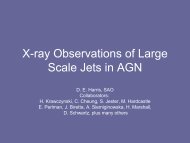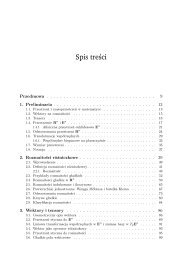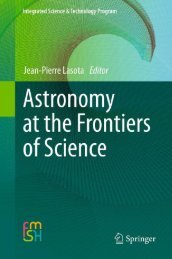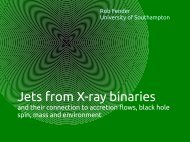Studying the Galactic Magnetic Field in the plane (so far)
Studying the Galactic Magnetic Field in the plane (so far)
Studying the Galactic Magnetic Field in the plane (so far)
You also want an ePaper? Increase the reach of your titles
YUMPU automatically turns print PDFs into web optimized ePapers that Google loves.
Large-scale models for Milky Wayvan Eck et al. (2010)The only certa<strong>in</strong>ty is that <strong>the</strong>reare puzzl<strong>in</strong>g reversals.Many models that may fit <strong>so</strong>meof <strong>the</strong> data (<strong>the</strong>se all largelybased on RM). None fit all of<strong>the</strong> data.(Sun et al 2008,courtesy X Sun)(Vallée et al. 2005)Previous estimates of B RMS/B reg(Han et al. 2006)flawed, IMHO. (Roy et al. 2008)21-27 August 2011 T. Jaffe @ MFUIII, Zakopane
Previous workSun et al. (2008) total I @ 23 GHzB reg= 2 μG B ran= 3 μGMiville-Deschênes et al. (2008) model PI/IB reg= 3 μG B ran= 1.7 μG– Sun et al.: RMs and synchrotron at 0.408, 1.4, and 23 GHz. Al<strong>so</strong> study<strong>in</strong>g <strong>the</strong>rmal electron fill<strong>in</strong>g factor,coupl<strong>in</strong>g of <strong>the</strong>rmal electrons and turbulent field.– Miville-Deschênes (2008): templates at 408 MHz and 23 GHz plus spectral <strong>in</strong>dex model, fitt<strong>in</strong>g BSS B-field parameters.– Jans<strong>so</strong>n et al. (2009): 23 GHz plus RMs, MCMC analysis.Common feature: i<strong>so</strong>tropic turbulence. Uncerta<strong>in</strong>ties <strong>in</strong> <strong>in</strong>puts often enough to allowcontradictory models. But not for much longer!27 Apr 2010 T. Jaffe SISSA Colloquium
Geometry●Coherent contributes to RM forB ||and to I and PI for B perp.●Ordered contributes to I and PIperpendicular, but to RM varianceonly.●Random contributes only to I andto PI and RM variance.●(At high frequencies, outside ofFaraday regime.)●Be careful when read<strong>in</strong>g aboutand discuss<strong>in</strong>g “regular”,“random”, “turbulent”, etc.Our first aim: separate <strong>the</strong>sethree components.21-27 August 2011 T. Jaffe @ MFUIII, Zakopane
On <strong>the</strong> <strong>plane</strong>●●●●●●●Ideally, want total I and PI at samefrequency. But you can't .Synchrotron total I low enough to avoidfree-free contam<strong>in</strong>ation but high enoughto avoid ab<strong>so</strong>rption.Synchrotron PI high enough to avoidFaraday depolarization effects.Need extragalactic RMs to trace fullLOS through GalaxyStep features <strong>in</strong> I: arms?Peaks and troughs <strong>in</strong> RM: arms?Reversal(s)?21-27 August 2011 T. Jaffe @ MFUIII, Zakopane
Motivated by external galaxies:Model<strong>in</strong>g●3D magnetic field model:– spiral arm model for 'coherent' field;– small-scale turbulence based on GRF withpower law spectrum;– compression model to produce amplificationas well as stretched ani<strong>so</strong>tropic (ordered)component along arm ridges based looselyon Broadbent (1989).●3D CRE density and spectral model: exponentialdisk with power law spectrum, p=-3, normalizedbased on gamma-ray data.●3D <strong>the</strong>rmal electron density model: both constantas well as NE2001 (Cordes and Lazio 2002).●Hammurabi code (Waelkens, Jaffe, et al. 2009) to<strong>in</strong>tegrate observables along LOS.An example of <strong>the</strong> coherent field model.●MCMC (cosmoMC) eng<strong>in</strong>e to explore parameters.21-27 August 2011 T. Jaffe @ MFUIII, Zakopane
Examples: coherent- With a rea<strong>so</strong>nableestimate for n e, RMsgive B coh.- With a rea<strong>so</strong>nableestimate for n cre, thisshows you need a lotmore to get I profile.21-27 August 2011 T. Jaffe @ MFUIII, Zakopane
Examples: i<strong>so</strong>tropic & homogeneous- Added simple GRF.- No step features => B ranshould be amplified <strong>in</strong>arms.- Polarization still lack<strong>in</strong>g,s<strong>in</strong>ce i<strong>so</strong>tropic randomcomponent cancels out,add<strong>in</strong>g only variance.21-27 August 2011 T. Jaffe @ MFUIII, Zakopane
Examples: i<strong>so</strong>tropic- Amplification ofrandom field <strong>in</strong> arms,but still i<strong>so</strong>tropic.- Step features appear,though too peaked.- PI rema<strong>in</strong>sunderpredicted, s<strong>in</strong>ceas before, i<strong>so</strong>tropicrandom contributionscancel out.21-27 August 2011 T. Jaffe @ MFUIII, Zakopane
Examples: compressed/shearedRandom field stretchedalong arm giv<strong>in</strong>g orderedcomponent <strong>in</strong> addition to<strong>the</strong> i<strong>so</strong>tropic randomcomponent. Now roughlymatches all threeobservables.PI not very well modeled<strong>in</strong> <strong>in</strong>ner galaxy. More todo!(Note that this is essentially acartoon to illustrate <strong>the</strong> effects, nota fit to <strong>the</strong> data.)21-27 August 2011 T. Jaffe @ MFUIII, Zakopane
Coherent |B|First results- 8 parameters fit: φ 0, a 0-a 4(arms+r<strong>in</strong>g), B RMS, f ord- Orientation of spiral matchesNE2001 <strong>the</strong>rmal electron model.- Reversal <strong>in</strong> Scutum-Crux armand “molecular r<strong>in</strong>g”.Total |B|- Coherent, i<strong>so</strong>tropic random,ordered field energy densities <strong>in</strong>ratios of 1:5:3. (Roughly 2, 4,and 3 μG along arm ridges.)- Weak Sag-Car<strong>in</strong>a arm?Mentioned <strong>in</strong> Benjam<strong>in</strong> et al.(2005) us<strong>in</strong>g GLIMPSE counts.Two dom<strong>in</strong>ant arms? But whatabout reversal(s)?Jaffe et al. (2010)Ma<strong>in</strong> limitation: assumes simple power law CRE spectrumfrom 408 MHz to 23 GHz. But CRE spectrum degenerate withf ord.To break <strong>the</strong> degeneracy, need additional dataset.Interest<strong>in</strong>gly, 2.3 GHz total I is not compatible with thismodel!21-27 August 2011 T. Jaffe @ MFUIII, Zakopane
Cosmic ray electrons:or, real life isn't a power lawUse full <strong>in</strong>tegration over CREenergy spectrum at eachpo<strong>in</strong>t <strong>in</strong> 3D galaxy model:(See, e.g., Rybicki & Lightman)I ∝∫ LOSdl∫ 0∞dx B perp n CRE F xx≡ c c ≡ 3 2 B perp2 mcThen add a synchrotron data po<strong>in</strong>tto analysis, e.g. 2.3 GHz total I.Jaffe et al. (2011): Spectra above few GeVconstra<strong>in</strong>ed us<strong>in</strong>g γ-ray data, Strong et al. (2010).Below a few GeV, determ<strong>in</strong>ed us<strong>in</strong>g synchrotron:J(E) ~ E -1.3 , slightly harder than usually assumed.Note that at low energies, <strong>so</strong>larmodulation affects localmeasurements.(GALPROP code: Strong & Moskalenko 2001;Data: Fermi LAT Collaboration 2009-10, Duvernois et al. 2001, Aguilar et al.2002)21-27 August 2011 T. Jaffe @ MFUIII, Zakopane
High-latitude with CRE spectrum- Strong, Orlando, & Jaffe (2011) analysis of synchrotron from 45 MHz to 23 GHzconstra<strong>in</strong>s low-energy (< few GeV) CRE spectrum.- Us<strong>in</strong>g Fermi CRE and gamma-ray data.- GALPROP CRE propagation as well as synchrotron prediction.- H<strong>in</strong>ts of fairly large CRE halo (~4kpc).21-27 August 2011 T. Jaffe @ MFUIII, Zakopane
More high-latitude dataWMAP K-bandpolarization anglecompared toprediction for ASspiral model field.Planck will do evenbetter and <strong>in</strong>cludepolarized dust, andC-BASS will do5GHz.Taylor et al. (2009)RM catalog.GALFACTS will doeven better overArecibo sky.21-27 August 2011 T. Jaffe @ MFUIII, Zakopane
High-latitude <strong>in</strong>clud<strong>in</strong>g dust- Fauvet et al. (2011) jo<strong>in</strong>tmodel<strong>in</strong>g of synchrotron anddust us<strong>in</strong>g profiles <strong>in</strong> lon andlat, WMAP K-band andARCHEOPS 353 GHz.- Results used to predictpolarized foregrounds forPlanck, <strong>in</strong>clud<strong>in</strong>g highlatitudepower spectra.See al<strong>so</strong> poster by L.Fauvet.21-27 August 2011 T. Jaffe @ MFUIII, Zakopane
Ongo<strong>in</strong>g work- Add polarized dust emission. Our simplemodels completely wrong at 94 GHz;<strong>in</strong>terest<strong>in</strong>g! Try Hoang & Lazarian models.- New RM data from Van Eck et al. (2011)fill<strong>in</strong>g gap toward Sag and r<strong>in</strong>g tangent.Not compatible with a logarithmic spiral?Interest<strong>in</strong>g!●Can we constra<strong>in</strong> <strong>the</strong> relationship betweenB-field and gas spiral arms?Planck:- Better synchrotron/free-free separation,particularly when comb<strong>in</strong>ed with C-BASS.- More sensitive polarized dust maps atmultiple frequencies.21-27 August 2011 T. Jaffe @ MFUIII, Zakopane
To remember:●●●●You need many different and complementary observables to study <strong>the</strong> differentcomponents of <strong>the</strong> galactic magnetic field. In particular, an ani<strong>so</strong>tropic/orderedturbulent component cannot be neglected <strong>in</strong> any estimate of a “regular” or“random” component based on diffuse emission like synchrotron and <strong>the</strong>rmaldust.We need to improve our component separation on <strong>the</strong> <strong>plane</strong> and tounderstand both <strong>the</strong> free-free <strong>in</strong>tensity and <strong>the</strong> polarized emissivity of <strong>the</strong>rmaldust. Planck!We need to better study <strong>the</strong> impact of realistic magnetic field models, <strong>in</strong>clud<strong>in</strong>gturbulence, on foreground separation for CMB experiements.The prospects look good with Planck, Fermi, C-BASS, GALFACTS, SKA, etc.21-27 August 2011 T. Jaffe @ MFUIII, Zakopane
21-27 August 2011 T. Jaffe @ MFUIII, Zakopane










